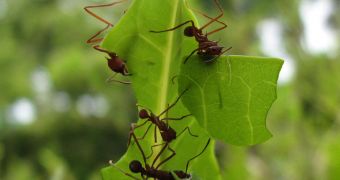Biologists have been fascinated by leaf-cutter ants for years, due to the tremendously-complex society they developed, and the visible impact they have on their environment for their size.
Oftentimes, we overlook ants as small, insignificant creatures, but we could learn a thing or two from them, especially in terms of how to build a fair society, in which everything works like clockwork.
The way an ant colony runs resembles a well-choreographed dance, in which each member of the ensemble executes their part to perfection. When conflicts occur, they are immediately and swiftly taken care of for the good of the colony, which then prevails.
In the case of the leaf-cutter ants, the most important members of the nest are the workers, which travel great distances from the nest on chemicals trails to collect pieces of leafs that are larger than themselves, and bring them back for the colony to use.
“Anyone who has ever come across a trail of ants cutting leaves and watched that trail run through the forest can recognize how charismatic, and what kind of large impact they have on the tropical ecosystems in which they occur,” explains Cameron Currie, who is an expert in bacteriology.
He and his team are investigating these ants in order to become able to develop better drugs and cleaner energy sources for humankind to use. The US National Science Foundation (NSF) is supporting the investigation.
“My doctoral work on leaf-cutting ants was not from an 'Oh, we can discover enzymes for bio-energy,' or 'Oh, we can discover antibiotics for medicinal use',” the expert adds.
“It was from a fascination with understanding the interaction of organisms in the natural world,” adds Currie, who now holds an appointment at the University of Wisconsin-Madison (UWM).
He says that one of the amazing things about leaf-cutter ants are their gardens. They have learned to live in communion with a species of fungus, which allows them to have both food sources and living space right in their very nests.
What's interesting is that the workers are not responsible for moving the leafs inside the nests. Smaller ants called minima are in charge of this, because they can move more easily through the gardens.
“This includes elaborate behaviors for tending their food crop. So, they actually groom it, and clean it, and prune it,” Currie explains. He adds that the health of the fungus garden is safeguarded by bacteria on the bodies of ants.
Their nests are therefore one of the most finely-tuned examples of symbiosis, and illustrate the results of millions of years of evolution.

 14 DAY TRIAL //
14 DAY TRIAL //